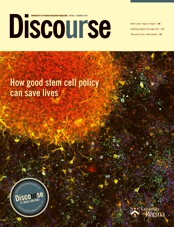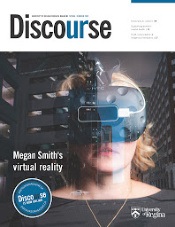Thomas Hadjistavropoulos is helping to end widespread pain in dementia patients. (Photo by Trevor Hopkin)

The video is difficult to watch. An older man in a wheelchair is rocking and vocalizing, visibly agitated and upset. When two care workers come to his side to offer comfort and a glass of water, the man swats them away with his hands, yelling, “No!” It’s obvious that care staff are trying their best to help him, but the senior’s agitation is only getting worse. One of the nurses then bends down to eye level and says, “Bill, we have medicine to help calm you down.”
Unfortunately, it’s a scenario that is repeated far too often in long-term care homes across Canada and around the world, as confused older patients who have lost their ability to verbally communicate are given psychiatric drugs to calm their agitation, when they might have been better served by having their undiagnosed pain addressed.
It’s a dilemma that has consumed the University of Regina’s Thomas Hadjistavropoulos for much of his academic career. After decades of research and collaboration with stakeholders, researchers, and health professionals across Canada, he has recently launched a worldwide social media campaign to raise awareness about the assessment and management of pain in older patients living with dementia. The #SeePainMoreClearly campaign has quickly spread around the globe since going live on October 1, 2019.
GOING VIRAL
“In the first five weeks of this campaign, our hashtag received more than three million impressions on Twitter and more than 1.6 million unique users. The story has been picked up by media across Canada, while the hashtag has been used in 14 countries and the website has been viewed in 22 countries. We have support from the Alzheimer’s Society of Saskatchewan, the AGE-WELL Network of Centres of Excellence, the Canadian Association on Gerontology, the Chronic Pain Network, and other organizations and influencers,” says the homespun hero, who, along with his undergraduate honours student Louise Castillo, decided to use the power of social media to address a real and growing problem in society.
In the same way that a high-stakes rescue video of an abandoned, half-starved puppy goes viral on social media in a matter of hours, Hadjistavropoulos and Castillo knew that they could harness that same power for their compelling message on how to help vulnerable seniors.
“Our goal is simple: we want to get the message across that, too often, pain-related distress and agitation in older adults with dementia is misattributed to psychiatric problems,” the psychology professor and director of the Centre on Aging and Health explains. “When we do this and pain problems go undiagnosed, they often get worse, costing the system significant resources. With improved pain assessment, we would not only be improving the quality of life of our seniors, but also reducing stress levels for care workers.”
“In the first five weeks of this campaign, our hashtag has received more than three million impressions on Twitter and more than 1.6 million unique users."
The #SeePainMoreClearly campaign is a natural fit for Castillo. As someone who grew up with social media, she’s seen firsthand how it has revolutionized the way people communicate with each other. “We wanted to find a way that would take scientific findings, which are often exclusive to academics, and put them on a social media platform,” the 21-year-old psychology student explains. “This way, the findings can be more accessible to the everyday public, including family members and caregivers.”
Normally it takes 17 years from the time research is conducted to the time it makes it into widespread clinical practice. The #SeePainMoreClearly campaign is helping to bridge that gap. “We’re getting our research findings out there to the general public in quick, digestible bites on social media,” Castillo says. “We’ve created the video and other engaging content that people can share and use to strike up important conversations. Our hope is that this will help shape future policy when it comes to how we treat dementia patients.”

PAIN ASSESSMENT CHECKLIST
Hadjistavropoulos and former graduate students Shannon Fuchs-Lacelle and Sarah Chan, along with other collaborators, have developed and validated the Pain Assessment Checklists for Seniors with Limited Ability to Communicate scales, known as PACSLAC.
Healthcare professionals are encouraged to assess such markers as facial expressions (grimacing, tightening of the facial muscles), vocalizations (crying out, grunting, gasping for breath), body movements (flinching, thrashing, clenching fists), to name a few, as ways to assess whether a patient is in pain. “Right now, long-term care facilities are only mandated to assess a patient for pain once every three months, but we believe that everyone should be assessed for pain at minimum once per week to ensure the health and well-being of those with limited ability to communicate,” says Hadjistavropoulos.
As many as 80 per cent of residents living in long-term care suffer from some kind of pain, which often can be excruciating. Frequently, responsive behaviours in dementia, from agitation to refusing to eat or shower, are due to unaddressed pain. Despite the best intentions of front-line staff, long-term care homes are often understaffed and underfunded. As the baby boomer population ages, and increasing numbers of older persons are diagnosed with dementia, there is often not enough time to do frequent pain assessments. But these frequent assessments can make a big difference. “In our research, we have found that nurses who use the PACSLAC on a regular basis have lower levels of distress and burnout than other nurses,” he says. “In another study, we found that regular pain assessments can lead to reduced use of anti-anxiety meds (benzodiazepines) in seniors with dementia, which can increase the risk of falls and the risk of mortality in that population.”
Currently, Hadjistavropoulos is collaborating with computer scientists and engineers to develop advanced technologies such as a tablet app and an automated vision system where cameras capture the facial cues of dementia patients using real-time video imaging to determine the level of pain a patient may be experiencing. These technologies help care staff better respond to the pain needs of their dementia patients.
PATIENT ADVOCATES
Patient advocate Mary Brachaniec of Moncton, N.B., is working with Hadjistavropoulos and his team to move research knowledge into the hands of those who need it. She believes effective pain management is a basic human right.
“My parents both suffered with Alzheimer’s and passed away in 2018. The biggest fear that my sister and I had was that they would experience pain and not be able to tell us about it,” Brachaniec explains. “This was the case for our mother after she fractured her pelvis from a fall in 2017. She spent 10 days in an acute care hospital where staff were very busy and didn’t have time to consistently monitor or manage her pain. This was distressing as she couldn’t tell us when her pain was too much. My sister and I recognized when her pain was increasing through facial grimaces or gasping, and we alerted staff. However, medication and other pain management measures were often not administered on time, causing much suffering for her and distress for us.”

Brachaniec’s story underscores the fact that even with family present, and staff doing their very best, the system is often constrained and pain can often be missed or underestimated and under-treated. Brachaniec says the consistent use of validated pain evaluation and management protocols for hospital staff would have gone a long way in easing her mother’s suffering and reducing the family’s burden.
“Once Mom was back in long-term care, staff worked closely with us to keep her comfortable, but even staff members who knew her well sometimes missed cues that her pain levels were increasing and she required further evaluation and treatment.”
THE GENESIS
Nobody wants to see a loved one in pain and unable to communicate. When Hadjistavropoulos was a young boy living in Greece, he watched his own grandfather’s decline with dementia. It left an indelible imprint on his life, but at the time, he didn’t know it would help form his future life’s purpose.
“I first thought about coming to Canada after I became fascinated by a famous Canadian, the poet Leonard Cohen, who had spent several years on the Greek island of Hydra,” says the registered doctoral psychologist. “I applied to 16 American universities for my undergraduate psychology studies and only one in Canada – McGill University – simply because I was hoping to bump into Leonard Cohen in Montreal where he was then living. I was happy when the McGill acceptance letter came, and I knew it was the right choice.”

Not only did Hadjistravopoulos get to meet his idol at a book signing event right across from the university, but he also found the local food and culture of Montreal suited him. In spite of so many positives, Hadjistavropoulos admits it was lonely being so far away from his family and friends in Greece, and the isolation pushed him to study harder and make something of himself. “It was a huge sacrifice coming to Canada, and it cost me a lot emotionally. I knew I had to make school a success, and this would be one of the driving forces of my life.”
Hadjistavropoulos then moved west to Saskatoon to obtain his master’s degree and his PhD. It was there that he met his future wife, Heather Hadjistavropoulos, a psychology undergrad from Swift Current who was “smart, beautiful, and made me laugh.”
The couple married and had two sons, Nicholas and Dimitri, while continuing their academic careers.
Heather Hadjistavropoulos became a renowned psychologist in her own right and a leading Canadian researcher in Internet Delivered Cognitive Behavioural Therapy (ICBT). Thomas ended up doing his pre-doctoral residency at the University of British Columbia Hospital, Vancouver.
While in Vancouver, he met Kenneth Craig, a renowned clinical psychologist and Canadian researcher on the forefront of behavioural advancements in undetected pain in infants and children.
“It was a match made in heaven,” Hadjistavropoulos laughs. “We realized that the problems of understanding pain in severe dementia patients and in infants posed similar challenges because they both have limited ability to communicate. It led to some exciting research and an innovative collaboration.”
Craig’s affection and admiration for his friend is unwavering. “How can you not want to work with someone so friendly, bubbly, and generous. He’s so driven to help seniors with dementia and so dedicated to his science and to professional scientific communities as a whole. He has developed a state-of-the-art program, and his passion and commitment to this project will be his greatest gift to others,” says Craig.
LEGACY
Louise Castillo agrees. “Everything I’ve done with the #SeePainMoreClearly campaign is because of Thomas and his vision. I’m just so happy to be a part of all of this, helping to change so many lives.”
Mary Brachaniec says the #SeePainMoreClearly campaign is causing important conversations to take place on a subject that is deeply personal and private. “We need to talk about this and change policy and practice so that dementia patients can live out the rest of their lives with comfort and dignity.”
Hadjistavropoulos may not have been able to help his grandfather those many years ago, but today he is systematically making life better for aging parents and grandparents living with dementia the world over. And that will be his greatest legacy.












